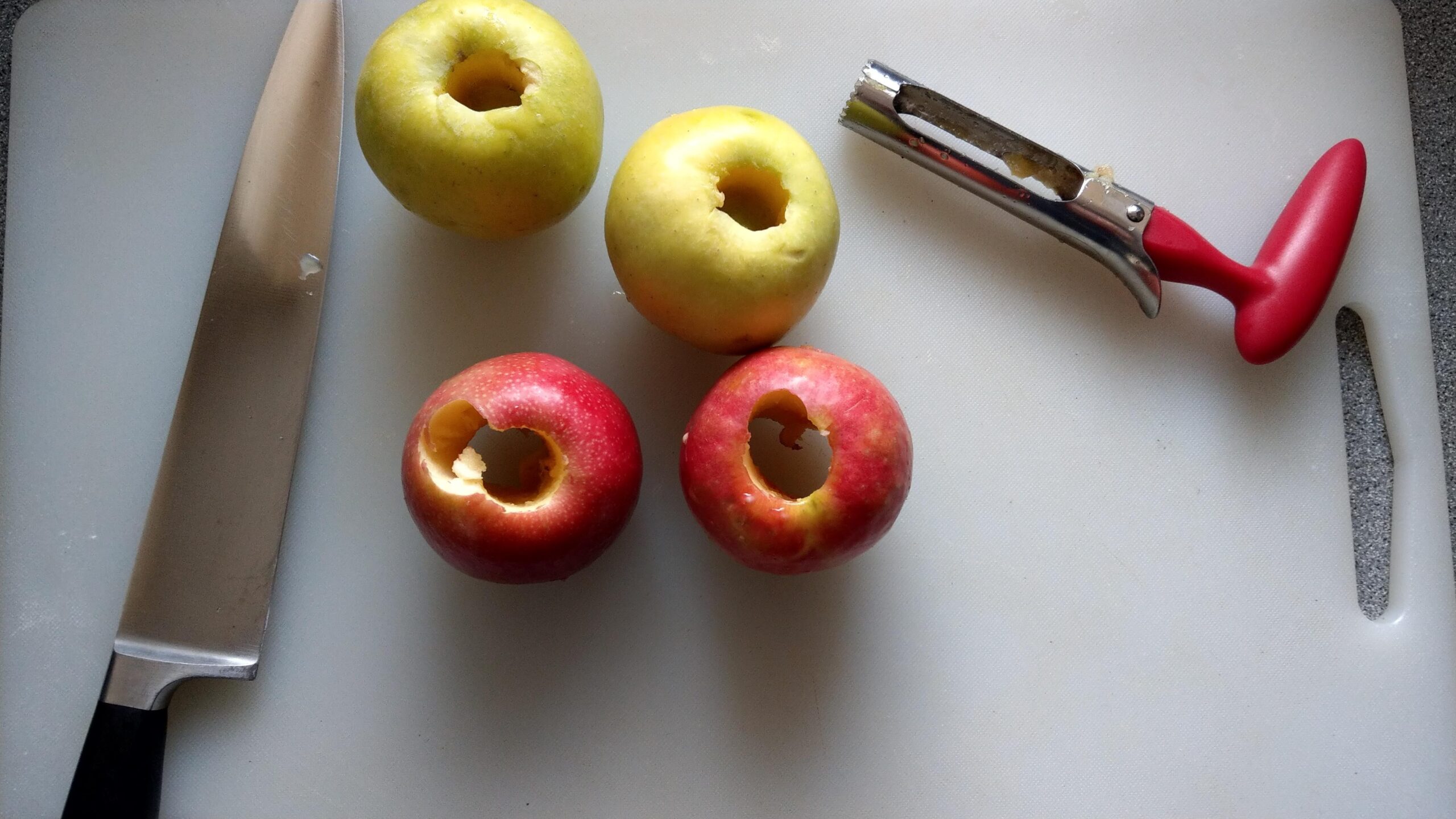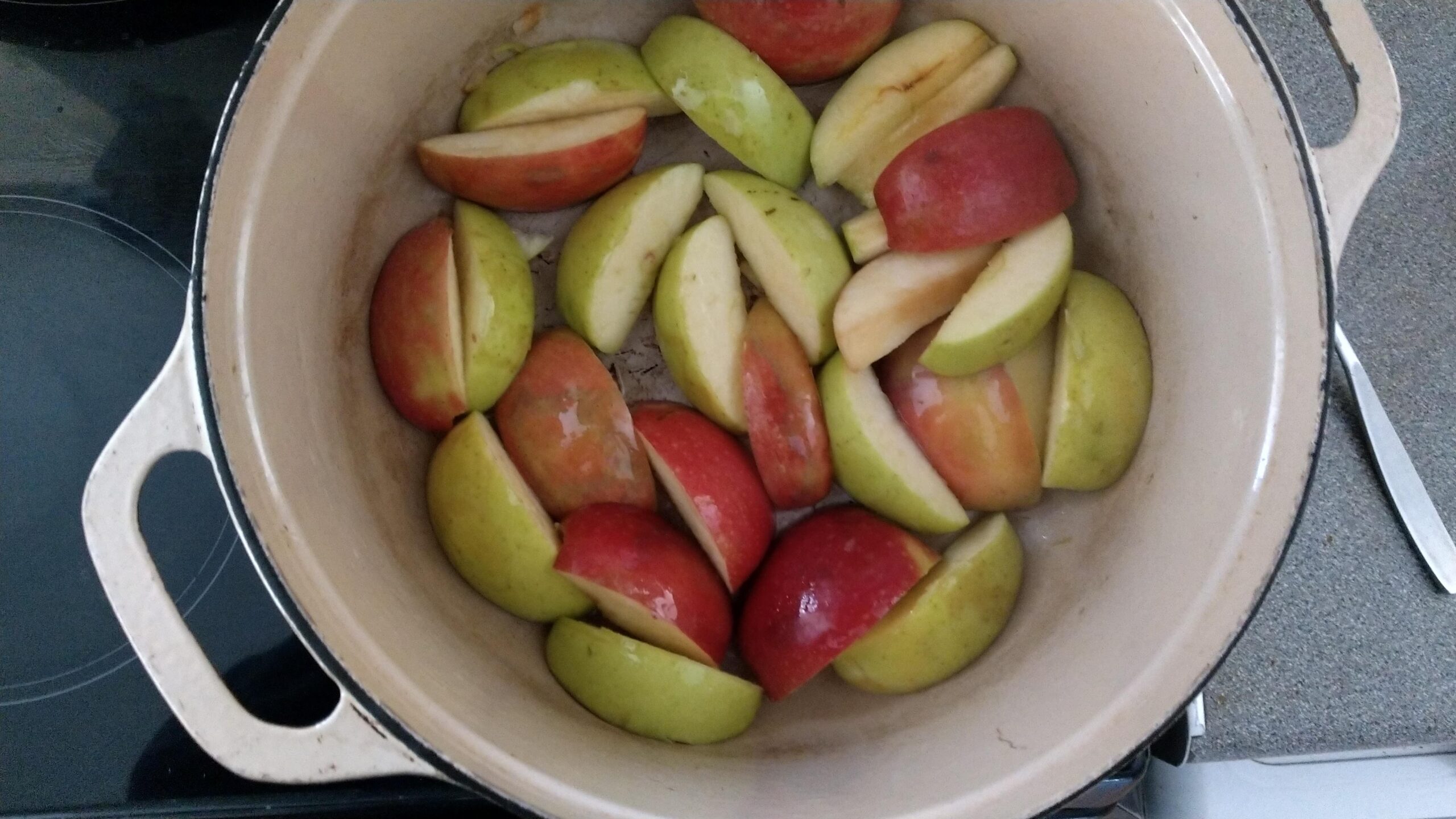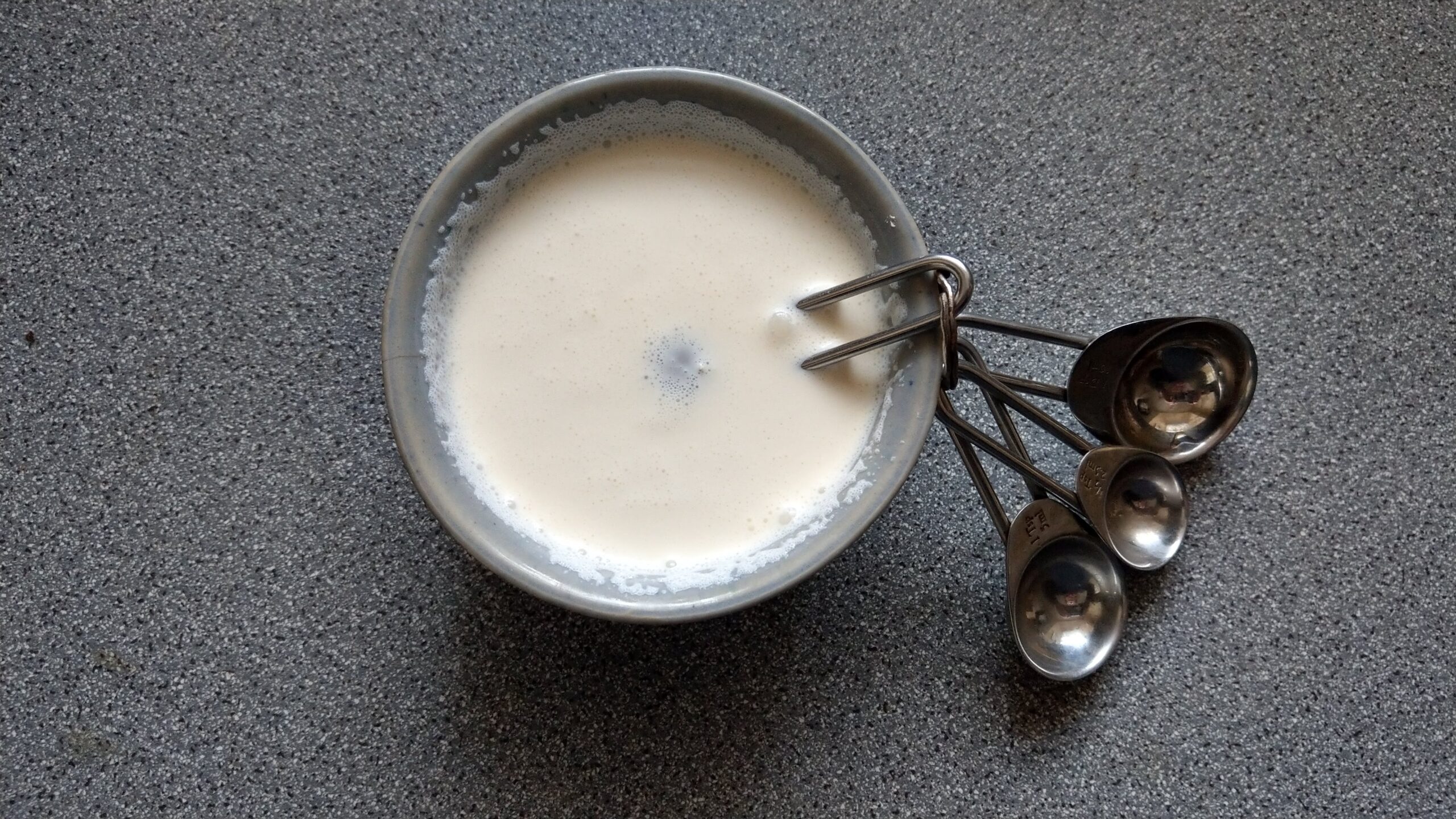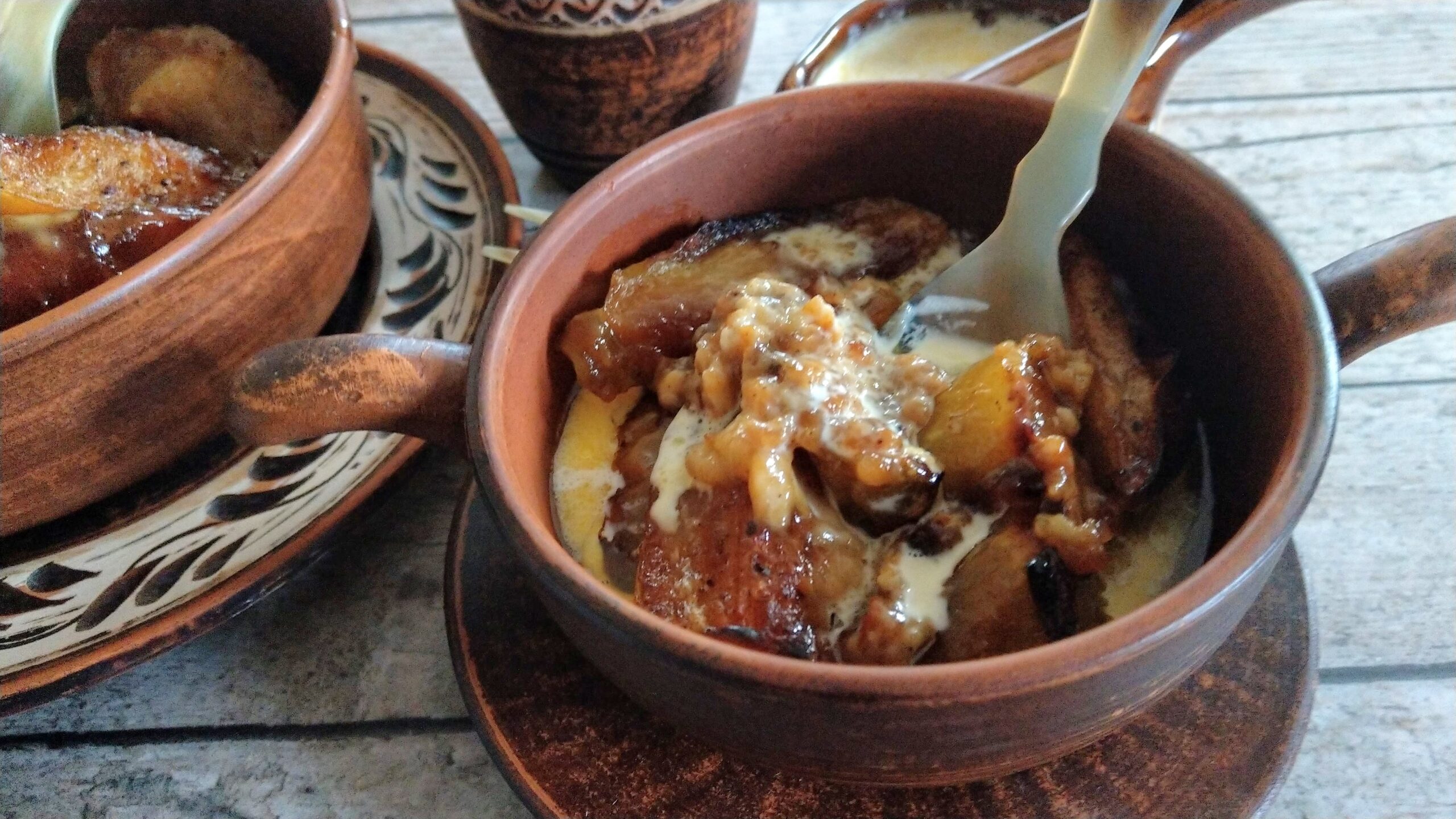Winter Apples in Cream
A dessert option in the Darthene style for out-of-season or slightly tired apples
- Background
- Recipe
It’s easy to forget, when you’re inside a modern Western culture, how insulated we tend to be from issues surrounding the seasonality of fruits and vegetables. Only when the taken-for-granted supply and storage chains surrounding us come under pressure or break down—as they did in a surprising number of places during the first onslaught of COVID-19—are we forced to remember that it’s not normal to have spring-harvested fruit in the depths of winter… or in early spring, long before the next fruiting season.
Our pre-world-food-industry ancestors handled this situation, where they could, by noting and pre-emptively propagating (by graft or seed) species and varieties of orchard fruits that were known to be “late bearers”, and were reliably ready for harvesting as late in the year as possible, rather than during the summer. The best of these, because of the firmness of their flesh even when ripest—and also because of their relatively low water content—have always been apples.
As a result of those centuries of quiet labor, home apple growers worldwide now have a whole recognized class of “winter apples*” to choose from, including varieties like Granny Smith, Goldrush, McIntosh, Roma and Fuji. On the southern-hemisphere continent that’s home to the Middle Kingdoms, the best winter-friendly apple breeds were developed over centuries in the far south (since the northern Seaboard regions, and North Arlen, are far too warm for even the more temperature-sensitive apples to prosper in such near-subtropical conditions). Such varieties, with antique and evocative breed-names like Eye-i’-the-Cave, Downriver Darling and Hoarfrost, are traditionally planted side by side in the orchards with the “summer fruits”. This is apparently a callback to the old Darthene and Arlene saying “The winter does the summer good”—though there are (inevitably) endless arguments among orcharders over just what this adage means.
In the Kingdoms, food industries are universally regional, routinely artisanal, and largely nontechnical (except where magic-workers of one kind or another get involved). As a result, the Four Realms’ professional orcharders and household apple-growers alike handle the business of overwintering fruit in exactly the same way as apple growers on our Earth did before chemical spraying, refrigerated warehousing, and inert-gas storage became available. Their apples are harvested with utmost care not to bruise the fruit or even let it fall from branch to ground… as damaged or skin-broken apples will not only go bad by themselves, but also spoil all the fruit around them. (Once upon a time, in both our worlds, apples were routinely overwintered in barrels… giving rise to proverbs about what it’s like when just one apple goes wrong: its wrongness invariably spreads.**)
The apples are then individually wrapped in cushioning and/or insulating material—in the Kingdoms, wool-fleece is a favorite—and the crates in which they’ve been tucked away are then stored somewhere cold, dark and airy to ride out the time until the next year’s fruiting season. Some breeds of apple, if correctly packed and kept, can last a year or more after harvest. Naturally the interior textures of such storage apples are never going to match the sharp crisp snap of an apple just plucked off the tree. But the saying in both Darthen and Arlen is “Better a winter apple than no apple at all.”
Over the centuries, ever so many recipes have appeared across the Four Realms for treating such apples in ways that will minimize the mealiness that storage apples inevitably acquire as they lose water content over time. Often a combination of frying and baking is involved. The thinking seems to be that the frying will help stabilize the apple’s structure somewhat and help it keep from turning into mush during whatever cooking process is going to happen to it next.
The popular recipe we’re using here seems to have originated in the south of Darthen (the ground long pepper is a bit of a giveway, as is the cream and the liberal use of butter). Over time, this approach has spread—or been independently re-invented—Realms-wide.
And inevitably there are places where the local take on the dish involves the cook offering the baking pot a hearty slug of the local applejack (or other apple spirit) once the boiling of the cream has died down a bit. It’s easy to see this as a poorly-concealed excuse for the cook to partake—not to mention (as with Segnbora, when this dish comes out at the end of a dinner with some of her Holders in The Landlady) the other dinner participants as well. The excuse for breaking out the applefire would have been the very commonplace “Come on now, you need something to help cut all that cream!”
In any case, the dish—with or without the additive—makes a warming and pleasant end to a winter dinner. Check the right-hand tab above for the recipe.
*Not to be confused with the Australian fruit Eremophila debilis, sometimes called “winter apple”.
** “It’s never just one,” the Arlene version of the proverb says. The Darthene version adds in somewhat cryptic mode, “The best we can hope for is applesauce.”
The ingredients:
- 4 apples (baking or eating apples, it doesn’t matter)
- 0.25 cup butter
- 0.25 cup brown sugar (We used a Demerara for this, but a Muscovado would probably be more authentic, as when Kingdoms cooks use sugar at all, they prefer less-refined ones. The browner the sugar, the better.)
- 0.5 cup heavy cream
- 2-3 tablespoons of vegetable oil
- Pinch of salt
- 0.25 teaspoon ground long pepper
- A few grinds or a large pinch each of: nutmeg, allspice, ground mace (More if you like, or have a favorite… A little cinnamon would also work here, if you feel like it.)
To thicken the cream while cooking:
- 1 tablespoon cornstarch (Middle Kingdoms cooks would use bulrush-root starch for this, but cornstarch is easier for us to get hold of…)
- 1 tablespoon water
- 4 apples (baking or eating apples, it doesn’t matter)
- The method:
Preheat the oven to 220C/450F.
While it’s heating: Core the apples. (There’s no need to peel them unless you really dislike apple peel. Leaving the peels on helps the slices hold together during cooking.)

- Cut each apple into thick slices. Six slices per apple is a good size.

- In a large pot with a heavy bottom, heat the vegetable oil. Add the apples and begin frying them slowly, sprinkling in the salt and spices.

Do the best you can to keep the flesh side of the slices down. Try to make sure both sides of each apple slice get at least a little frying time: enough to at least color the slice on that side, if not to get it well browned. Ten to fifteen minutes of frying should be enough.
While this is going on, in a small measuring cup (or similar), add the water to the cornstarch and mix well together until smooth. When mixed, add the cream and stir well to blend.

When the browning of the apples is complete, remove the pot from the heat.
Pour the cream into the pot and swirl the pot around to mix the cream with the apples. (You can stir them together with a spoon if you like, but be very gentle about it, as the apples will already be softening significantly.)
Dot the apple-and-cream mixture with the butter, and put the whole business in the oven to bake for fifteen to twenty minutes, until the cream has thickened and is bubbling in the heat. At least once during this period—twice if you feel inclined—take the pot out and baste the apples with the cream: then put it back to finish baking. (You can add a little more cream at this point if you feel what’s in the pot has gone too thick.)
At the end of the baking time, remove the pot from the oven, divvy the cooked apples up among individual bowls for your guests, spoon the hot cream over each bowlful, and serve.

Enjoy!
(And if you wanted to serve this over a good vanilla ice cream, no one in the Kingdoms would argue the point. They like a nice vanilla ice as well as anyone else…)
Fruit, desserts, dairy



